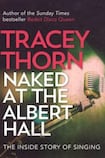
Tracey Thorn's first book Bedsit Disco Queen was an understated chronicle of life as a musician. It wasn't overtly confessional, but what made it so compelling was Thorn's gift as a storyteller, weaving facts and dates into a sharp, funny narrative. In the introduction here, the Everything But the Girl singer says that some reviews of Bedsit Disco Queen conflated two things about her: "Many listeners already liked 'me' . . . because they liked my singing voice, and readily identified my writing voice as belonging to the same person." Naked at the Albert Hall is Thorn's exploration of singing, songs and countless singers, filtered through her complex relationship with her own voice. Mercifully unencyclopedic, it's an engrossing whirl through everything from accents, miming, stage fright, microphones and how we define a singer by their voice. When Elvis Costello recorded Charles Aznavour's She for the Notting Hill soundtrack, he asked writer Richard Curtis "Would you like me to do one as 'Elvis Costello'?" Gone was the romantic crooning, replaced by the sinister persona Costello's singing voice often has.
Communal chant
Singing is as individualistic as a fingerprint, but it can be a hugely communal experience, from church choirs to songs sung on football terraces. We sing at funerals to make sense of loss and belt out

Everywhere We Go-oh
on coach trips to make the miles whizz by. Research has shown that singing is good for us: whether as exercise or catharsis, it lowers the blood pressure. The voice isn’t always thought of as an instrument, and Thorn points out that until 1979, singers were not allowed to join the American Federation of Musicians and had to apply as a player of say, guitar or flute. But the voice is an instrument and the most interesting sections of the book deal with the physiology of singing, citing numerous sources.
John Potter explains the mechanics of voice in his book Vocal Authority: "a power supply (the lungs), an oscillator (the cords, or vocal folds) and a resonator (the vocal tract, consisting of the mouth and throat cavities)". Air comes from the lungs, passing through the vocal cords, which vibrate and produce sound. Because these mechanics vary according to anatomy, each voice is unique to each singer. Thorn points out that inhaling fluid at birth and her subsequent asthma shaped the way her vocals sound.
Finding a voice is central to every singer's story. When Thorn discovered Patti Smith, it wasn't just about a performer who was as non-conformist in her lyrics as her image: Smith had the "perfect, ideal vocal range. Still the place I most like to sing." If singing within this framework is about learning confidence and technique, Thorn equally deals with her own experiences of stage fright. Her last album was released in 2012 but she hasn't sung on stage since 2000. Hypnosis didn't work and her fear of singing live, of sharing her voice with others, is common to many singers. A chapter on Dusty Springfield reveals that she was so insecure about her singing that during the recording of her legendary Dusty in Memphis album, she turned the level of her headphones up full to block out her own voice over the music.
What we like in a singer is highly subjective. It's worth paraphrasing Yeats to ask "how can we separate the singer from the song"? I have induced gasps for saying I don't like Leonard Cohen's or Bob Dylan's singing, but I recognise their huge ability as songwriters. To me, Kate Bush has a unique and brilliant vocal; to others it's melodramatic and screechy. Thorn admires Blur, but can't stand Damon Albarn's voice, but she explores the vocally interesting, from Karen Carpenter to The Unthanks, in a chapter on folk songs and accents. All are real people with an enduring gift, that can be YouTubed for posterity (try everything from Count John McCormack to Screamin' Jay Hawkins).
Song in fiction
Any reader will find much to love in the sheer number of bookish references, and how the singer, and singing, is represented in fiction. From Willa Cather’s 1915 novel
The Song of the Lark
, to Joyce’s
Ulysses
(
Sirens
in particular) and the titular
Shirley
from Charlotte Bronte’s novel. When she sings for a group of guests, her passion is interpreted as “strange” and “improper” for a girl. Thorn can relate, and concludes the book with her own manifesto: “Sometimes I just sing for the sake of it: because I can and because I want to. I just sing”.
In exploring her see-saw relationship with her own voice, Thorn has created a fascinating, engaging look at a world that is often taken at face (or note) value. Sinéad Gleeson presents The Book Show on RTÉ Radio 1













